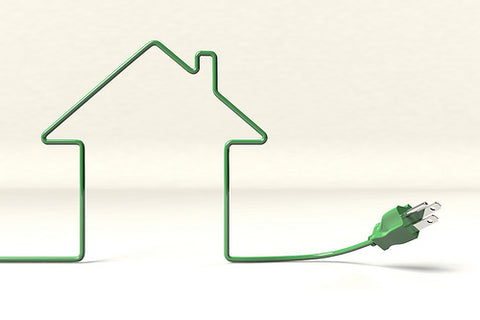Once upon a time, before the invention of home heating and cooling systems, homes were designed to maximize energy efficiency. They did this by designing open homes that encouraged airflow and modifying the landscape in order to channel cool breezes. With rising energy costs and larger carbon footprints, many people are looking to save money and reduce the amount of pollution that they produce. However, did you know that you can do all that and more by using clumping bamboo plants?

Active & Passive Cooling
There are 2 common strategies for energy efficient home cooling, active and passive. Simply put, active cooling uses energy, such as an air conditioner, while passive cooling does not use any mechanical means.
It has always been important in southern regions to block the sun, and channel tropical winds. However, the hot, moist climate of Florida presented an especially challenging environment for energy efficient design. In days gone by, Florida homes were often designed with large porches that were capable of shading walls and windows. In addition to this, they were often positioned so as to take advantage of existing trees and the shade that they provided.
Benefits Of Using Energy Efficient Landscaping Design
Today, numerous people are looking for cost-effective, energy efficient, and curb-appealing landscaping options. Smart, environmentally friendly home and landscape design has many benefits, especially when it comes to reducing energy costs and the impact on the environment. According to the Department of Energy, properly placing up to three trees could save homeowners anywhere between $100 and $250 each year.
The main goals and benefits of energy-efficient landscaping include:
- Reducing noise and air pollution
- Cutting energy costs
- Reducing consumption
- Reducing surface temperatures
Research has shown that groups of trees have a greater impact on cooling surrounding areas than the same number of trees would if they were scattered throughout the landscape. “Carefully positioned trees can save up to 25% of the energy a typical household uses for cooling (U.S. DOE, 2007).”
Shade is not the only consideration in the amazing cooling effect of plants. Plants have pores in their leaves that release large amounts of water, as a result there is a cooling effect that creates an area of cooler air surrounding the plant. By using plants such as bamboo, for wind and shade control, you can take advantage of this evaporative cooling effect to cool your home and surrounding areas, and reduce your home’s energy consumption.

Using Bamboo for Energy Efficient Design
While trees are the most commonly cited plants for energy efficient design, there are many benefits to using bamboo instead. Unlike trees, clumping bamboo plants generally reach their full height and maturity within 3 to 5 years. They can also reach the same heights as most trees, require minimal maintenance and are highly versatile.
Planning Before You Start
Careful planning and design is one of the most essential aspects in creating an energy efficient landscape. One of the easiest ways to begin is by considering specific problems about your current landscape that you would like to correct.
- Does your home have air conditioning will rely on passive cooling? (This is a major effect on what type of landscape techniques you should use.)
- Are there moisture or humidity problems on any one side of the home?
- Would your home be more energy-efficient if certain windows were shaded?
- Would the front or back yard be more appealing is wind movement were encouraged?
These are just a few examples of the questions that you should ask when planning your energy efficient landscape design. This allows you to tailor your design to meet your specific needs. A few key tips that you should remember when creating your energy efficient landscape is to:
- Choose plants and their placement carefully in order to ensure the least maintenance and the highest energy-efficiency.
- Reduce the amount of pesticides, fertilizer and water that you have to use.
- Choose maintenance equipment that is energy efficient.
- Shade your house and AC unit, but do not block its circulation and keep it free of debris.
It is also important that you take care not to over-shade your home as this may actually cause it to have higher energy and maintenance bills. By ensuring that your home is provided with sufficient ventilation, it can receive periodic drying by the wind and sun. This also reduces how hard your AC unit must work in order to control humidity and how often the lights have to be on.

Providing Shade & Reducing Heat
There is much more to creating an energy efficient landscape than simply providing shade. Plants and shade trees will not be effective in reducing energy bills if they are not planted in the appropriate places. Not to mention, it costs much less to prevent heat from entering your home than it does to cool it down once it is hot. In order to successfully reduce the amount of heat that enters your home, you must first understand the 3 ways that the sun penetrates your home.
- Direct Radiation (Direct solar radiation from the sun that reaches earth’s surface.)
- Reflected Radiation (Indirect radiation that bounces off of surfaces, such as driveways, patios, etc.)
- Re-Emitted Radiation (Solar radiation that is stored in a surface, such as brick, concrete or pavement, and released later on in the day.)
When deciding how to shade your home, it is important to consider all 3 sources of heat. However, your first target areas should include glass doors and windows that are facing south, east and west.
Clumping bamboo plants are great choice for landscaping and shading your home. They typically reach full maturity within 2 to 3 years, providing a great deal of foliage and are sturdy enough to withstand a good amount of wind.
Landscaping For Air Conditioned Homes
You can accidentally increase your energy costs by improving wind circulation around your home in the summer. For air conditioned homes, increased wind movement can cause your home’s cooling system to work harder as hot air is more likely to infiltrate your home through openings and cracks around doors and windows. This is why you want to position plants so as to divert hot summer breezes away from your home.
Here are a few tips for landscaping for air-conditioned homes:
- Protect your windows from air movement by using low branching trees on the southwestern and southeastern sides of your lot.
- Create a ‘wind ramp’ that channels air up and over the home by creating a windbreak that is multilayered on the southern side.
- You can reduce warm air infiltration and help insulate your home by creating a space for dead air next to walls that are facing summer winds.
- For Central and North Florida, you can use deciduous shrubs along walls that face the South in order to allow passive solar heating during the winter.
Finally, one of the most important things you can do to improve your home’s energy efficiency is to ensure that your air conditioning unit is shaded. This reduces the amount of energy that your air conditioning unit must use in order to cool your home. However, it is important that you make sure to keep it free of debris and do not block the airflow of the unit. You can also place the condensation over for pipes so that they are away from your home, which reduces moisture buildup.
You can use clumping bamboo plants for shade, wind brakes and more. Due to their tall and fast growth rate, they can be used to replace trees in many landscaping environments. Bamboo plants are evergreen and can be mixed with a variety of deciduous shrubs to create an amazingly efficient design.

Check Out Our Clumping Bamboo Plants Now
Creating an energy efficient landscape design for your home is one of the most essential things that you can do to reduce your energy consumption. While every energy efficient landscaping design is unique, these are just some of the most basic steps that you can take to begin landscaping with bamboo for energy efficient homes in Florida.
photo credit: 3D Green Energy via photopin (license)
photo credit: Toulouse, France via photopin (license)
